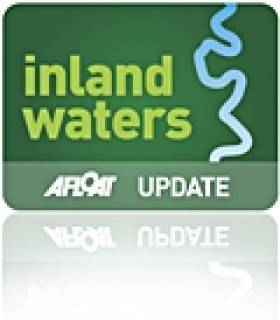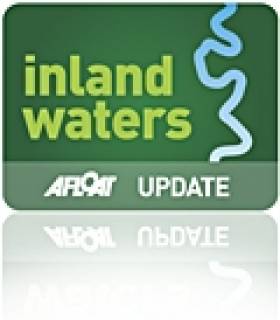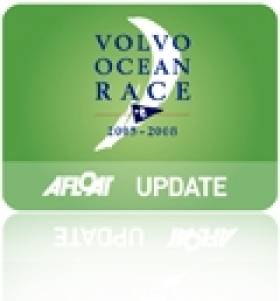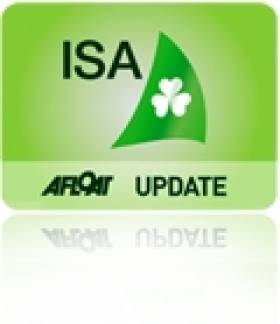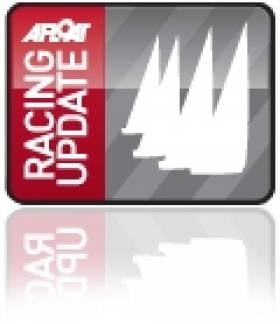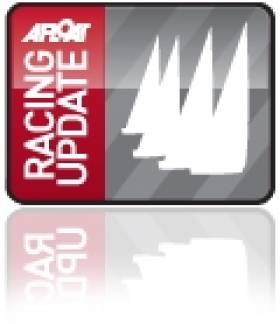Displaying items by tag: Royal
Canal Mooring Rules Change
#canals – Waterways Ireland has recognised that many boat owners wish to stay for a more extended period in a single location than the five days the annual Canal Mooring and Passage Permit (under the Canals Act, 1986 (Bye-laws), 1988) currently allows.
In response, Waterways Ireland intends to issue an Extended Mooring Licence granting a boat owner the right to leave their boat in one location for longer than 5 days. This permit will enable the holder to moor in a position allocated by Waterways Ireland on a soft bank area of navigation property for a period of up to 1 year. The Extended Mooring Licence will cost €152 per annum.
The application process for the Extended Mooring Licence will open in the autumn when all existing permit holders will be contacted.
All boat owners will still require an annual Canal Mooring and Passage Permit allowing the holder to cruise and pass through locks. Boat owners with a Canal Mooring and Passage Permit proposing to stay longer in one location than 5 days can then apply for the Extended Mooring Licence. The total fee to hold both the Permit and the Licence in 2012/2013 will be €278.
For boat owners with the Canal Mooring and Passage Permit who do not hold an Extended Mooring Licence the 5 day rule (in the one place or within 500m of that location) will still apply. Waterways Ireland will enforce this bye-law from autumn 2012.
Waterways Ireland will be contacting permit holders regularly between now and autumn 2012 to ensure they are kept up to date with the roll-out of the new permit. All queries about the enforcement of the current bye-laws or the Extended Mooring Licence should be directed to Shane Anderson, Assistant Inspector of Navigation: Tel no +353 (0)87 286 5726, Email [email protected] .
These changes are necessary steps to improve the management of the canals and waterway amenities for both the navigational and recreational user, so that investment in the new infrastructure and facilities which Waterways Ireland has undertaken is maximised for every user.
Royal Alfred Yacht Club Revive the Superleague for 2012
#SAILING–A new sailing league for 2012 to bring an 'extra focus' to yacht racing in Dublin Bay was the talk of last night's Royal Alfred Yacht Club (RAYC) black-tie awards dinner in Dun Laoghaire. The RAYC racing club will re-launch the 'Superleague' concept – first staged in the 1990s – to a new generation of sailors in 2012 with the aim of 'rewarding the best boats, skippers and crews', across the whole season, in each class in Dublin Bay, the country's biggest sailing centre.
The Superleague will be open to all classes of keelboats in Dublin Bay. In 2011 there were 15 keelboat classes with 300 boats. Visitors from Howth or elsewhere will also be welcomed in to the league.
The Superleague will consist of 10 individual events/races - six club Regattas - Dun Laoghaire Motor Yacht Club, Royal Alfred Yacht Club, Howth Yacht Club, National Yacht Club, Royal Irish Yacht Club and Royal St George Yacht Club - together with four Dublin Bay Sailing Club Saturday races - 1 in May, July, August and September. There will be four discards with six results to count.
Royal Alfred Commodore Peter Beamish believes the Superleague will bring an extra focus to racing in Dublin Bay without adding to an already cluttered event fixture list. It will increase the incentive to all boats to participate in the individual events which make up the Superleague. The club will also be awarding crew prizes which they hope will help boats build and motivate crew panels.
The hope is to provide very close overall results with final results in the balance right up to the last race in the series.
Full details of the RAYC superleague are being finalised and will be available in mid-December.
Winter Closures on the Royal Canal, Grand Canal and Barrow Navigation
#WATERWAYS – In its latest marine notice Waterways Ireland has advised masters and owners of vessels that the following planned closures will be in place for the winter of 2011-2012.
GRAND CANAL – MAIN LINE
2nd Lock, Inchicore The canal will be closed at the 2nd Lock from December 2011 to February 2012 for the replacement of lock gates.
Ardclough The canal will be closed east of Henry Bridge to facilitate the laying of a storm water culvert by Kildare County Council – dates to be confirmed.
Tullamore The canal will be closed from 7th November 2011 to 5th March 2012 to facilitate the construction of three footbridges and a boardwalk by Tullamore Town Council.
Ballycommon The canal will be closed to facilitate dredging – dates to be confirmed.
GRAND CANAL – BARROW LINE
Glenaree to Rathangan The Barrow Line will be closed between 22nd Lock at Glenaree and 23rd Lock at Rathangan from 1st November 2011 to 17th March 2012 to facilitate dredging.
ROYAL CANAL
Spencer Dock, Newcomen Bridge There will be no further lifts of Newcomen railway bridge until the 2012 boating season.
1st to 5th Locks, Dublin The locks will be closed from November 2011 to March 2012 for repairs to the gates.
5th and 6th Levels, Cabra The canal will be closed until January 2012 for dredging and relining of the channel.
8th Lock, Reilly’s Bridge The lock will be closed from November 2011 to March 2012 for repairs to the gates.
33rd to 34th Lock The canal will be closed for essential maintenance works – dates to be confirmed.
Mosstown Harbour to 41st Lock The canal will be closed for essential maintenance works – dates to be confirmed.
BARROW NAVIGATION
Bagenalstown Lock The lock will be closed for essential maintenance – dates to be confirmed.
Galway Revives Ancient 'Royal' Yacht Club
The 'Royal Galway Yacht Club' (RGYC) was established in 1892 but had not been heard of for quite some time. But in 2011 it has set sail again, becoming the latest Yacht Club on the Irish sailing scene and an addition to the clubs operating on Galway Bay.
It has four flag officers (three Commodores and one Admiral) and it will have 'no royal aspirations'in spite of the name according to promoter Enda O'Coineen.
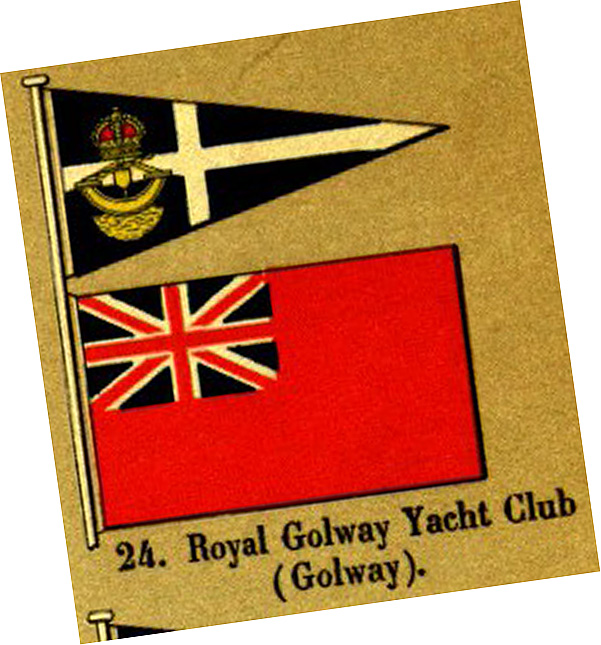
An 1800s representation of the club burgeee
In an open letter sent recently to VOR supporters, O'Coineen says the RGYC has been revived as 'a slightly unconventional club'.Anyone taking matters too seriously in the newly revived club Afloat.ie understands runs the risk of being 'black balled'.
Presumably what a yacht club in the Republic of Ireland cares to call itself is no longer of any concern to the British Home Office?
The club's intended purpose now is to promote youth sailing.
Kenefick, Mansfield, Allen and Duncan Progress to All Ireland Finals
Racing is taking place in flight two this afternoon in gusty 12 knot winds under race officer Geoff O'Donoghue of Lough Derg Yacht Club.
All three Dun Laoghaire helms competing in this morning's first flight were eliminated. Missing the cut by a single point are Mermaid champion Roger Bannon, David Gorman of the Flying fifteens and Alan Claffey of the Ruffians. Also going home is Donegal GP14 Champion John McGuinness.
Flight 1 Results|
Flight |
Boat |
Name |
R1 |
R2 |
R3 |
Total |
|
1 |
7 |
George Kenefick |
1 |
1 |
2 |
4 |
|
1 |
1 |
Mark Mansfield |
2 |
2 |
1 |
5 |
|
1 |
2 |
Adrian Allen |
8 |
3 |
3 |
14 |
|
1 |
6 |
Ben Duncan |
4 |
6 |
4 |
14 |
|
1 |
5 |
Roger Bannon |
5 |
5 |
5 |
15 |
|
1 |
3 |
Alan Claffey |
6 |
4 |
6 |
16 |
|
1 |
8 |
David Gorman |
3 |
7 |
7 |
17 |
|
1 |
4 |
John McGuinness |
7 |
8 |
8 |
23 |
Day One of the Autumn Sailing Regatta commenced at 8.30 am yesterday when Royal Cork Yacht Club was jam packed and rocking with the excitement of the Ireland vs Italy rugby match writes Claire Bateman. (SCROLL DOWN FOR GALLERY)
After the glorious Irish victory the fleets headed out into the mist hoping that a bit of breeze would fill in. The mood was buoyant and the atmosphere sizzling but alas and alack on attempting to set a course the hard working David O'Brien, Principal Race Officer for Classes 3, 4 and whitesail, on Admiral Paddy McGlade's Sabone, would appear to have encountered the wrath of the weather gods who must have been rooting for the Italians today! As the Race Officer described it "the fog would roll away for some 200 yards and some minutes later it would roll back in again" and at times it was raining and other times it was dry.
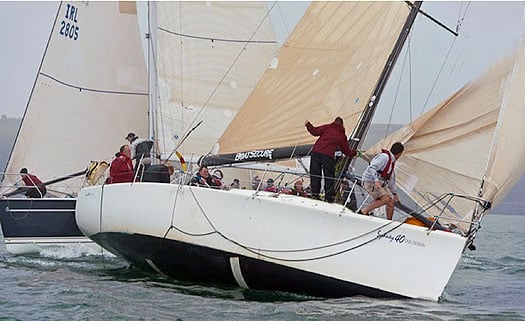
Once the fog lifted, there was some breeze for racing. Photo: Bob Bateman. More photos below.
The fog descended and visibility was so reduced he couldn't even see the pin end of the line that had just been laid. However, after a short delay the a small breeze filled and the fog lifted sufficently to enable a start. Class 3 were first away with the exception of Outrigger who had to return to start having been over the line. Then it was the turn of the Whitesail fleet who headed off into the mist accompanied by a number of dolphins.
Meanwhile Classes 0, 1, 2 and 1720s, under PRO Richard Leonard, stayed in the harbour where they sailed windward/leeward courses with a start off Spike and despite the conditions they managed two races . The committee boat for these fleets was kindly provided by Paschal Healy who had on board the Senior partner of the sponsor firm, Irene O'Donovan, assisting with Race duties. In the second race for these fleets Buoys 10 and 16 were used for the windward/leeward course giving Classes 0 and 1720s three rounds and Class 1 two rounds. Towards the final round the wind died and crews struggled to round 16 before the wind filled in enough to get all boats finished.
Given the conditions it was a wonderful achievement to get in any racing at all for the large fleet on the day and hopefully next Sundays' racing will enjoy better conditions and will return to the scheduled start time of 11.55am.
Sharkbait Wins By a Single Point at SB3 National Championships
The young pretender Ross Vaughan RNIYC took line honours in race one. But it was the experience of 1988 and 1992 Olympian Peter Kennedy who lead after day one with two wins. Hot on his heels going into Saturday were top Irish performer at this year's worlds, Mel Collins of RCYC sailing Sibelus, and last year's Champion Gareth Flannigan from Ballyhome YC.
Day two which ended up as the final day, included the first two races in the north of Dublin Bay. Jack Roy moved the fleet towards Dalkey Island for the final race.
A second place by RIYC Alan McGettigan's Defiant in race four skippered by Colin Galavan, was the hosts club best result over the weekend. Andrew Algeo sailing Flutter was best placed Dun Laoghaire boat with some very consistent results finishing sixth overall.
But it was Sharkbait sailed by Ben Duncan, Brian Moran & Ric Morris representing Howth YC who prevailed with some excellent results. Including two wins and two seconds brought them over the finishing line to win from Ridgefence by one point. The Howth team sailed superbly all weekend and thoroughly deserved their victory.
"This was a very well run regatta by Paul McCarthy RIYC and Mark McGibney sailing manager.
Another very successful year for the SB3 class, with 39 entries for our Nationals, and the quality throughout the fleet, making it the most competitive class on the island " said Jerry Dowling, SB3 National Chairman and organiser of this year's National Championship.
The last SB3 Regatta is the Midlands hosted by Lough Ree YC 15 -16 th 2011.
Eighth Place Overall for O'Leary at New York Invitational Cup
Anthony O'Leary ended up in the same position as he started the New York Yacht Club Invitational Cup after yesterday's final rounds. The Royal Cork crew counted a 15 in the final race to end up eighth, the same as Monday's opening score. The sole Irish invitees were as high as sixth last Thursday.
In a reversal of fortunes from the inaugural event two years ago, the Terry McLaughlin-led team from the Royal Canadian Yacht Club persevered today to win the 2011 New York Yacht Club Invitational Cup presented by Rolex, sailed in Swan 42s. The New York Yacht Club team finished second, with the Annapolis Yacht Club team, third. The final race days' light and shifty conditions gave all 22 teams the opportunity to shift positions on the leaderboard, but in the end most just solidified what they had already earned.
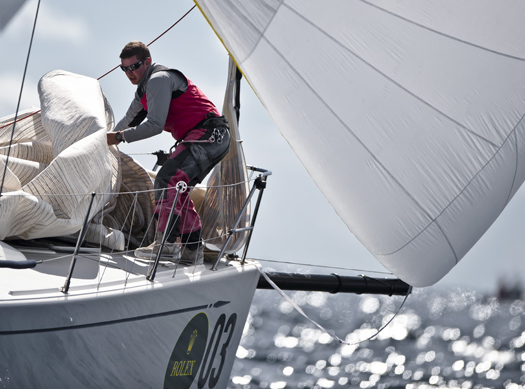
Royal Cork's entry finished eighth in New York. Photo: Kurt Arrigo/Rolex
The Canadian entry, skippered by Olympic medalist and former America's Cup skipper, Terry McLaughlin, went into the day – and the final race – with a ten-point lead over the New York Yacht Club entry. But the Canadians took charge from the start, McLaughlin recounted their strategy, "We decided to go after New York, but it was tricky. It was five knots at the start, but it was very, very shifty and puffy, so if we let them sail their own race and we had tried to sail our own race. There is a reasonable chance that they would have put ten boats between us, so we decided that 'ok listen' we've got to be near them. If we put them back at the start and we're back at the start than it doesn't matter and we couldn't lose.
"But, we still both had reasonable starts at the right end and we went right a little bit. Then they (NYYC) sort of got to us a bit, so I bailed left, but we happened to be in a great puff and gained on them a lot."
The Royal Canadian Yacht Club team, from Toronto, sailed a nearly flawless series with seven top five finishes – out of eleven races sailed. In races where the Canadians were deep in the fleet, McLaughlin, tactician John Togerson and crew inevitably overhauled the boats ahead. McLaughin said, "I think we came back quite well this series. Obviously yesterday was our best, going from nineteenth to sixth. Its important because you can't get off the line in great shape or get around the first mark in great shape, eleven races in a row."
The 55-year old sailor won a silver medal in the Flying Dutchman class in the 1984 Los Angeles Olympics and was the skipper of Canada I in the 1983 America's Cup challenger series. In fact, three of his current crew were holdovers from that Cup campaign. These days his business is importing clothing and footwear from Ireland, and his sailing more relegated to only occasional racing.
In a new addition to the event, the team leading in points at the end of each day flew a "gold" spinnaker in the following day's races. The Royal Canadian team quickly took that honor after the first day and never relinquished it for the week.
McLaughlin was quick to praise his crew, "It was a team effort. I mean, I make the final decisions, but I'm relying on guys that A) make the boat go fast and B) tell me what's going on."
Ken Colburn was skipper of the New York Yacht Club team, the only really viable threat to the Royal Canadian Yacht Club through the five days of racing, coming within five points midweek. Colburn was pleased, "You have to step back from this and say 'we came in second in this regatta to a team that was just doing everything well.' You've got to walk away from that pleased, with just slight disappointment that you didn't get all the way there. The Royal Canadian Yacht Club are the ultimate winner, and they deserve it."
Like many of the teams that only managed to get everyone in the same boat relatively late, the NYYC crew started sailing together for the first time over Labor Day weekend but, according to their skipper, they quickly gelled. Colburn from Marblehead, Massachusetts, was adamant that his crew was equally responsible for their success, "This is a team sport and I'm only driving the boat most of the time. I need tacticians and trimmers and strategists and bow people to do their jobs well, and they all did them superbly well. They were sportsmanlike, cordial, competitive, and always working to win, I couldn't be more proud of this team."
Peter McChesney, skipper of the Annapolis Yacht Club team which finished third, summed up what many competitors agreed, "It was certainly, arguably, the most unique, special, exciting regatta. The professional circuits, and Olympic campaigns, and lot of great one-design classes, but certainly this is a new unbelievable regatta with worldwide excitement."
While the North American teams dominated the top five overall positions, with Eastern Yacht Club, and Newport Harbor Yacht Club in fourth and fifth, the first international entry was the sixth-placed Japan Sailing Federation, skippered by Makoto Uematsu, followed by the Royal Ocean Racing Club (GBR), Royal Cork Yacht Club (IRL), Royal Hong Kong Yacht Club, and Yacht Club Argentino (ARG), rounding out the top ten finishers.
Following the success of the inaugural event in 2009, Event Chairman John Mendez and his Invitational Cup committee set to make several changes to improve the competition. Among these were changing to an all-amateur event, and on-the-water umpiring, both of which were unanimously well received by the competitors. Peter Shrubb, Chief Umpire from Bermuda, oversaw the ten-umpire team. Shrubb was pleased with the results explaining, "We're on the water and adjudicating any rule infractions. We can't catch everything, but we'd like to think we caught 95%. We resolve them on the water, and it saves the competitors having to file protests against each other – it take out of their hands, puts it into our hands and makes for a friendlier, more Corinthian event."
The final Rolex Awards Dinner was held under the marquee on the New York Yacht Club's Harbour Court grounds. Competitors and guests enjoyed dinner and dancing overlooking Newport Harbor.
The Royal Canadian Yacht Club team, overall winner of the Invitational Cup were awarded a Rolex Submariner timepiece and presented the Invitational Cup trophy, which was commissioned by NYYC Commodore Robert James and past NYYC Trustee, Charlie Robertson.
NYYC's Harbour Court hosted 22 yacht clubs – representing 16 nations from six different continents – for the second edition of this biennial event. Racing was conducted in NYYC Swan 42s on Rhode Island Sound and Narragansett Bay from September 10-17, 2011. The next edition of the New York Yacht Club Invitational Cup presented by Rolex will be held in September 2013.
Final Results – 2011 New York Yacht Club Invitational Cup
1) Royal Canadian Yacht Club, Canada, 47 points
2) New York Yacht Club, USA, 67 points
3) Annapolis Yacht Club, USA, 72 points
4) Eastern Yacht Club, USA, 89 points
5) Newport Harbor Yacht Club, USA, 105 points
6) Japan Sailing Federation, Japan, 105 points
7) Royal Ocean Racing Club, Great Britain, 112 points
8) Royal Cork Yacht Club, Ireland, 115 points
9) Royal Hong Kong Yacht Club, Hong Kong, 120 points
10) Yacht Club Argentino, Argentina, 121 points
11) Royal Yacht Squadron, Great Britain, 122 points
12) Nyländska Jaktklubben, Finland, 127 points
13) Cruising Yacht Club of Australia, Australia, 133 points
14) Clube Naval de Cascais, Portugal, 137 points
15) Norddeutscher Regatta Verein, Germany, 138 points
16) Royal Bermuda Yacht Club, Bermuda, 144 points
17) Royal Cape Yacht Club, South Africa, 148 points
18) Itchenor Sailing Club, Great Britain, 150 points
19) Royal Norwegian Yacht Club, Norway, 154 points
20) Yacht Club Capri, Italy, 167 points
21) Real Club Nautico de Barcelona, Spain, 197 points
22) Yacht Club Punta Ala, Italy, 220 points
Royal Cork Crew Moves up to Sixth at New York Yacht Club Invitational
Ireland's Royal Cork Yacht Club moved up two places overall in the Rolex New York Invitational Cup yesterday after scoring 3,10 and 11 in the 22 boat fleet yesterday. The Anthony O'Leary skppered boat is just three points behind Japan who ties for fourth place after six races with the Newport harbour team on 48 points. Third place is Annapolis Yacht Club on 43 points.
Returning to upper Narragansett Bay for the second day of the fixture has proven beneficial for at least one of the 22 yacht club teams – Royal Canadian Yacht Club – which again displayed remarkable consistency on the race course. And in a repeat of yesterday's prevailing theme of tight competition, today's three races were won by three different clubs which means that there have been no duplicate winners thus far in the six-race series.

A keen start yesterday. Royal Cork is bow number three. Photo:Dan Nerney/Rolex
"We were probably the biggest movers," said Peter McChesney, helm for the Annapolis Yacht Club team who has only sailed in Newport a handful of times previously, including the the New York Yacht Club Invitational Cup U.S. Qualifying Series in 2010 in which the AYC team finished second to earn the opportunity to race in this event. AYC was 10th overall after yesterday's first day of racing, and moved up to third overall with 43 points after finishes of 6-1-3 today. "We just got off the line better today in every race, and gave our tactician [John Torgerson] the opportunity to make good decisions. If you get a good start it's easier to make those decisions. Our tactician took what we gave him and did a great job of calling tactics, and the crew work was essentially flawless. Everything just went our way."
The exciting conditions seen today on Narragansett Bay have also proven why Newport remains such a unique place to sail. "Where else can you sail in 20 knots of breeze and have the seas be this flat?," said Chip Whipple, timmer on the New York Yacht Club team. "It really is an anomaly. When you have as much breeze as this [in the Med] you're sailing in big seas and a lot of swell. And in northern Europe you have the cold water and big seas, breaking waves. Being as protected as we are here it's just an extremely fantastic place to sail, and the boats can't sail any faster because they are absolutely optimized for the conditions."
The Royal Canadian Yacht Club (RCYC) team has retained the overall lead position after adding finishes of 2-4-2 to yesterday's finishes of 2-1-4 for 15 points. When they won the second race on the first day of the contest, they were given the Rolex gold spinnaker to fly in the subsequent race. And, as overall standings leader, RCYC carried the golden chute for all of today's races, and will continue that way when racing resumes tomorrow.
"We had to bail on two starts," said RCYC helm Terry McLaughlin after racing today, explaining that the RCYC team was forced to tack in both instances but the moves wound up working in their favor. "It was good breeze most of the day and we were going well. We're trying to do all the fundamentals well and not make mistakes." With eleven races planned, and tough competition, McLaughlin knows all to well that the 13-point lead RCYC currently enjoys can disappear in a hurry. "We had a good battle with NYYC in the last race, caught up to them on the last leg. It was close, but they beat us by three boat lengths."
"The last race was a lot of fun," said Ken Colburn, skipper of the New York Yacht Club team when summing up their win of the final race of the day. NYYC now stands second overall with 28 points, 13 points behind RCYC. "We had a great start, found ourselves in a clean lane and just were able to get in the proper groove. RCYC was there every inch of the race. We stayed together . . . gapped the fleet . . . for both of us it was just a fabulous race." Emphasizing that there was still a lot of racing to come, Colburn noted that, as anticipated, the quality and depth of the competition is remarkable. "Six winners in six races is indicative of how strong this fleet is overall."
Racing resumes today Thursday, September 15, with the warning signal for the first race scheduled for 1100. Competitors leave NYYC's Harbour Court for the race course at approximately 0930 each morning. The winner of the 2011 New York Yacht Club Invitational Cup presented by Rolex will be confirmed at the conclusion of racing on Saturday, September 17.
Dun Laoghaire Yacht Clubs Voice Concern Over Plan
Dun Laoghaire Yacht Clubs are voicing concerns about the impact on sailing if a 'cruise ship jetty' is constructed as part of the recently published harbour masterplan.
Dublin Bay Sailing Club, Dun Laoghaire Motor Yacht Club, National Yacht Club, Royal Alfred Yacht Club
Royal Irish Yacht Club and Royal St George Yacht Club. are also concerned about access to the water if a proposed 'pedestrian walkway' in front of the waterfront clubs was completed.
The clubs have engaged 'professional help' to prepare a submission to outine the concerns.
Also seen as a problem is the 'lack of sufficient facilities in the masterplan for hosting significant international sailing events'.
A survey in 2009 by the Irish Marine Federation (IMF) calculated a €3million spend by participants connected with the 500-boat Volvo Dun Laoghaire regatta. The clubs have previously stated they see the harbour's future as a leisure facility.
A masterplan model was on display by the Harbour Company in the month of August.
Writing to members in the current edition of the National Yacht Club's newsletter commodore Paul Barrington says the clubs 'hope to further engage with the harbour [company] to find a mutually acceptable way forward'.
Water Rat: Harbour Plan is a Curate's Egg





























